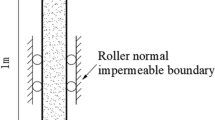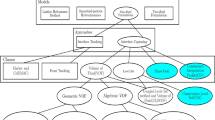Abstract
This paper discusses the development of a fully implicit discrete element method and its application to granular column collapse simulations. In the developed model, both the translational and angular velocities are solved implicitly and simultaneously. The model is verified by simulating a single particle bouncing on a flat surface and rolling on a slope; it is then validated through a granular column collapse simulation using many particles. The verification indicates that the restitution coefficient between the particle and the bottom surface estimated from the calculated results generally agrees with that of an input parameter, and the time-series variations of the translational and angular velocities of the particle on a slope are also in perfect agreement with the theoretical values. In the granular column collapse simulation, the performance of the proposed model with respect to the runout distance and deposition shape of the collapsed granular column is investigated in comparison to a previous experiment. The simulations are conducted for a total of ten cases by varying the initial aspect ratios of the granular column, and the calculated results are found to agree well with the experimental results.







Similar content being viewed by others
References
Cundall PA, Strack ODL (1979) A distinct numerical model for granular assemblies. Geotechnique 29:47–65. https://doi.org/10.1680/geot.1979.29.1.47
Lisjak A, Grasselli G (2014) A review of discrete modeling techniques for fracturing processes in discontinuous rock masses. J Rock Mech Geotech Eng 6:301–314. https://doi.org/10.1016/j.jrmge.2013.12.007
Fathipour-Azar H, Wang J, Jalali SME, Torabi SR (2020) Numerical modeling of geomaterial fracture using a cohesive crack model in grain-based DEM. Comput Part Mech 7:645–654. https://doi.org/10.1007/s40571-019-00295-4
González JM, Zárate F, Oñate E (2018) Pulse fracture simulation in shale rock reservoirs: DEM and FEM-DEM approaches. Comp Part Mech 5:355–373. https://doi.org/10.1007/s40571-017-0174-3
Ramírez-Gómez Á (2020) The discrete element method in silo/bin research. recent advances and future trends. Part Sci Tech 38:210–227. https://doi.org/10.1080/02726351.2018.1536093
Coetzee CJ, Els DNJ (2009) Calibration of discrete element parameters and the modelling of silo discharge and bucket filling. Comput Electron Agr 65:198–212. https://doi.org/10.1016/j.compag.2008.10.002
Gonzárez-montellano C, Ayuga F, Ooi JY (2011) Discrete element modelling of grain flow in a planar silo: influence of simulation parameters. Granul Matter 13:149–158. https://doi.org/10.1007/s10035-010-0204-9
Feng Y, Yuan Z (2021) Discrete element method modeling of granular flow characteristics transition in mixed flow. Comp Part Mech 8:21–34. https://doi.org/10.1007/s40571-019-00309-1
Mori Y, Sakai M (2021) Visualization study on the coarse graining DEM for large-scale gas-solid flow systems. Particuology 59:24–33. https://doi.org/10.1016/j.partic.2020.07.001
Mori Y, Sakai M (2021) Development of a robust Eulerian-Lagrangian model for the simulation of an industrial solid-fluid system. Chem Eng J 406:126841. https://doi.org/10.1016/j.cej.2020.126841
Tsuji Y, Kawaguchi T, Tanaka T (1993) Discrete particle simulation of two-dimensional fluidized bed. Powder Technol 77:79–87. https://doi.org/10.1016/0032-5910(93)85010-7
Golshan S, Sotudeh-Gharebagh R, Zarghami R, Mosotoufi N, Blais B, Kuipers JAM (2020) Review and implementation of CFD-DEM applied to chemical process systems. Chem Eng Sci. https://doi.org/10.1016/j.ces.2020.115646
Hobbs A (2009) Simulation of an aggregate dryer using coupled CFD and DEM methods. Int J Comput Fluid Dynam 23:199–207. https://doi.org/10.1080/10618560802680971
Azmir J, Hou Q, Yu A (2018) Discrete particle simulation of food grain drying in a fluidized bed. Powder Technol 323:238–249. https://doi.org/10.1016/j.powtec.2017.10.019
Hilton J, Ying D, Cleary P (2013) Modelling spray coating using a combined CFD-DEM and spherical harmonic formulation. Chem Eng Sci 99:141–160. https://doi.org/10.1016/j.ces.2013.05.051
Singh RI, Brink A, Hupa M (2013) CFD modeling to study fluidized bed combustion and gasification. Appl Therm Eng 52:585–614. https://doi.org/10.1016/j.applthermaleng.2012.12.017
Balaam NP, Poulos HG, Brown PT (1978) Settlement analysis of soft clays reinforced with granular piles. Proc. 5th Asian Conf Soil Eng 81–92
Bui HH, Fukagawa R, Sako K, Ohno S (2008) Lagrangian meshfree particles method (SPH) for large deformation and failure flows of geomaterial using an elastic-plastic soil constitutive soil. Int J Numer Anal Methods Geomech 32:1537–1570. https://doi.org/10.1002/nag.688
Ikari H, Gotoh H (2016) SPH-based simulation of granular collapse on an inclined bed. Mech Res Commun 73:12–18. https://doi.org/10.1016/j.mechrescom.2016.01.014
Aranson IS, Tsimring LS (2001) Continuum description of avalanches in granular media. Phys Rev E. https://doi.org/10.1103/PhysRevE.64.020301
Lagrée PY, Staron L, Popinet S (2011) The granular column collapse as a continuum: validity of a two-dimensional Navier-Stokes model with a μ(I)-rheology. J Fluid Mech 686:378–408. https://doi.org/10.1017/jfm.2011.335
Bui HH, Nguyen GD, (2017) A coupled fluid-solid SPH approach to modelling flow through deformable porous media. Int J Solids Struct 125:244–264. https://doi.org/10.1016/j.ijsolstr.2017.06.022
Gotoh H, Khayyer A (2018) On the state-of-the-art of particle methods for coastal and ocean engineering. Coast Eng J 60:79–103. https://doi.org/10.1080/21664250.2018.1436243
Tsuruta N, Gotoh H, Suzuki K, Ikari H, Shimosako K (2019) Development of PARISPHERE as the particle-based numerical wave flume for coastal engineering problems. Coast Eng J 61:41–62. https://doi.org/10.1080/21664250.2018.1560683
Ikari H, Yamano T, Gotoh H (2020) Multiphase particle method using an elastoplastic solid phase model for the diffusion of dumped sand from a split hopper. Comput Fluids 208:104639. https://doi.org/10.1016/j.compfluid.2020.104639
Razavitoosi SL, Ayyoubzadeh SA, Valizadeh A (2014) Two-phase SPH modelling of waves caused by dam break over a movable bed. Int J Sediment Res 29:344–356. https://doi.org/10.1016/S1001-6279(14)60049-4
Naito N, Meada K, Kohno H, Ushiwatari Y, Suzuki K, Kawase R (2020) Rockfall impacts on sand cushions with different soil mechanical characteristics using discrete element method. Soil Found 60:384–397. https://doi.org/10.1016/j.sandf.2020.02.008
Schmeeckle MW (2014) Numerical simulation of turbulence and sediment transport of medium sand. J Geophys Res-Earth 119:1240–1262. https://doi.org/10.1002/2013JF002911
Seli P, Pirker S, Lichtenegger T (2018) Onset of sediment transport in mono- and bidisperse beds under turbulent shear flow. Comp Part Mech 5:203–212. https://doi.org/10.1007/s40571-017-0163-6
Zhang B, Xu D, Zhang B, Ji C, Munjiza A, Williams J (2020) Numerical investigation on the incipient motion of non-spherical sediment particles in bedload regime of open channel flows. Comp Part Mech 7:987–1003. https://doi.org/10.1007/s40571-020-00323-8
Harada E, Tazaki T, Gotoh H (2020) Numerical investigation of ripple in oscillating water tank by DEM-MPS coupled solid-liquid two-phase flow model. J Hydro-Environ Res 32:26–47. https://doi.org/10.1016/j.jher.2020.07.001
Tazaki T, Harada E, Gotoh H (2021) Vertical sorting process in oscillating water tank using DEM-MPS coupling model. Coast Eng 165:103765. https://doi.org/10.1016/j.coastaleng.2020.103765
Harada E, Ikari H, Tazaki T, Gotoh H (2021) Numerical simulation for coastal morphodynamics using DEM-MPS method. Appl Ocean Res 117:102905. https://doi.org/10.1016/j.apor.2021.102905
Harada E, Gotoh H, Ikari H, Khayyer A (2018) Numerical simulation for sediment transport using MPS-DEM coupling model. Adv Water Res 129:354–364. https://doi.org/10.1016/j.advwatres.2017.08.007
Harada E, Ikari H, Khayyer A, Gotoh H (2019) Numerical simulation for swash morphodynamics by DEM-MPS coupling model. Coast Eng J 61:2–14. https://doi.org/10.1080/21664250.2018.1554203
Helbing D, Farkas I, Vicsek T (2000) Simulating dynamical features of escape panic. Nature 407:487–490. https://doi.org/10.1038/35035023
Gotoh H, Harada E, Andoh E (2012) Simulation of pedestrian contra-flow by multi-agent DEM model with self-evasive action model. Safety Sci 50:326–332. https://doi.org/10.1016/j.ssci.2011.09.009
Harada E, Gotoh H, Rahman NBA (2015) A switching action model for DEM-based multi-agent crowded behavior simulator. Safety Sci 79:105–115. https://doi.org/10.1016/j.ssci.2015.06.001
Samiei K (2014) Implicit and explicit algorithms in Discrete Element Method. LAP LAMBERT Academic Publishing
Tuley R, Danby M, Shrimpton J, Palmer M (2010) On the optimal numerical time integration for Lagrangian DEM within implicit flow solvers. Comput Chem Eng 58:211–222. https://doi.org/10.1016/j.compchemeng.2013.06.018
Jasion G, Shrimpton J, Danby M, Takeda K (2011) Performance of numerical integrators on tangential motion of DEM within implicit flow solvers. Comput Chem Eng 35:2218–2226. https://doi.org/10.1016/j.compchemeng.2011.02.017
Shi G (1992) Discontinuous deformation analysis: a new numerical model for the statics and dynamics of deformable block structures. Eng Comput 9:157–168. https://doi.org/10.1108/eb023855
Koyama T, Nishiyama S, Yang M, Ohnishi Y (2011) Modeling the interaction between fluid flow and particle movement with discontinuous deformation analysis (DDA) method. Int J Numer Anal Meth Geomech 35:1–20. https://doi.org/10.1002/nag.890
Gotoh H, Sumi T, Sakai T (2006) Numerical movable bed based on implicit distinct element method. Doboku Gakkai Ronbunshuu B 62(2):201–209. https://doi.org/10.2208/jscejb.62.201 (in Japanese)
Yoshida H, Masuya H, Imai K (1988) Impulsive properties of falling rocks on sand-layers by means of Cundall’s discrete block method. Doboku Gakkai Ronbunshu 392:297–306 (in Japanese)
Kawaguchi T, Tanaka T, Tsuji Y (1992) Numerical simulation of fluidized bed using the Discrete Element Method : the case of spouting bed. Transactions of the Japan Society of Mechanical Engineers Series B 58:2119–2125 (in Japanese)
Harada E, Gotoh H (2008) Computational mechanics of vertical sorting of sediment in sheetflow regime by 3D granular material model. Coast Eng J 50:19–45. https://doi.org/10.1142/S0578563408001715
Lajeunesse E, Monnier JB, Homsy GM (2005) Granular slumping on a horizontal surface. Phys Fluids 17:103302. https://doi.org/10.1063/1.2087687
Girolami L, Hergault V, Vinay G, Wachs A (2012) A three-dimensional discrete-grain model for the simulation of dam-break rectangular collapses: comparison between numerical results and experiments. Granul Matter 14:381–392. https://doi.org/10.1007/s10035-012-0342-3
Shimosaka A, Shirakawa Y, Hidaka J (2012) Effects of particle shape and size distribution on size segregation of particles. J Chem Eng Jpn. https://doi.org/10.1252/jcej.12we179
Gingold RA, Monghan JJ (1977) Smoothed particle hydrodynamics: theory and application to non-spherical stars. Mon Not R Astron Soc 181:375–389. https://doi.org/10.1093/mnras/181.3.375
Shao SD, Lo EYM (2003) Incompressible SPH method for simulating Newtonian and non-Newtonian flows with a free surface. Adv Water Res 26(7):787–800. https://doi.org/10.1016/S0309-1708(03)00030-7
Koshizuka S, Oka Y (1996) Moving-particle semi-implicit method for fragmentation of incompressible fluid. Nuclear Sci Eng 123:421–434. https://doi.org/10.13182/NSE96-A24205
Acknowledgements
This work was supported by JSPS KAKENHI Grant No. JP21H01433 and JP21K04271. We would like to thank Editage (www.editage.com) for English language editing.
Author information
Authors and Affiliations
Contributions
All authors contributed to the conception and design of the study. Material preparation and data collection and analysis were performed by HI. The first draft of the manuscript was written by HI. HG supervised the conduct of the study. All authors read and approved the final manuscript.
Corresponding author
Ethics declarations
Conflict of interest
The authors declare that they have no conflict of interest. No funding was received to assist with the preparation of this manuscript.
Additional information
Publisher's Note
Springer Nature remains neutral with regard to jurisdictional claims in published maps and institutional affiliations.
Rights and permissions
About this article
Cite this article
Ikari, H., Gotoh, H. Fully implicit discrete element method for granular column collapse. Comp. Part. Mech. 10, 261–271 (2023). https://doi.org/10.1007/s40571-022-00485-7
Received:
Revised:
Accepted:
Published:
Issue Date:
DOI: https://doi.org/10.1007/s40571-022-00485-7




